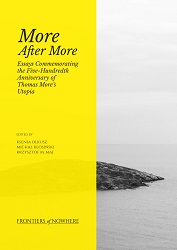
We kindly inform you that, as long as the subject affiliation of our 300.000+ articles is in progress, you might get unsufficient or no results on your third level or second level search. In this case, please broaden your search criteria.


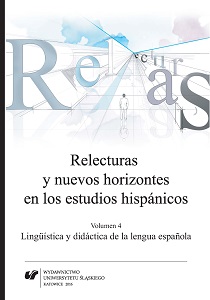
The present study focuses on some usage peculiarities of Spanish causative constructions «hacers(se) + Inf.», «dejar(se) + Inf.» in fiction texts translated into Spanish VS original ones. Though causative constructions do exist in many languages, they may show a wide number of asymmetric features (such as pronominal forms, present in Romanic languages, absent in English, Polish, Russian, Ukrainian, etc.). As there are frequently no direct equivalents in the original text for the causative constructions, more subjective factors can influence the translator’s decision whether to use them or not. Particularly, it turned out that translators tend to exaggerate a «favorite» construction or to underuse some stylistic devices. A million-tokens corpus demonstrates it to be a strong tendency in translated fiction text, unlike in the original ones.
More...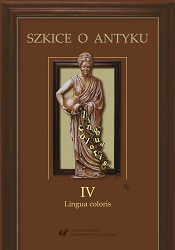
This article presents chosen passages from Roman literature, in which color epithets are collocated with nouns such as e.g.: gladius, flagellum, arcus or hasta. The aim of the text is to outline variety of the mentioned collocations as well as to describe their functions and explain interpretative problems with reference to historical and traditional context. The main emphasis is put on a conviction that color in literature let a reader construe (through senses) world and visions created by authors. It is possible to highlight personal characteristic thanks to vivid depictions and metaphors. Furthermore, color itself can lead into space of surprising solutions, noteworthy ideas and unusual descriptions, which have an impact of readers’ imagination.
More...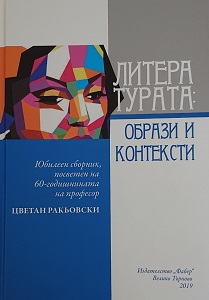
It is generally acknowledged that the fundamental anthropological modus of walking once transformed from a necessary and indispensable human activity into a matter of individual choice, emerged as ideology and was simultaneously appropriated into the realm of „the fictive and the imaginary“ (in W. Iser’s terminology), which brought about the conceptualization of the literary peripatetic. Meanwhile, attributed to that same modern ideology was an ancient legacy traced back to Aristotle’s school of philosophy. The paper is concerned with the re-actualization of the peripapetic in Modernism – that is to say, with the conceptual, cultural, and textual aspects ofwalking, represented in modernist novels, evaluated in the perspective of the alternating historical, ideological, aesthetic, philosophical, and poetical contexts, that construct the complex narrative rationalizing the interconnectedness between walking and thinking, and walking and writing.
More...
The focus of the current study is the perception of the Italian literary classics by influential figures in Bulgarian literature like Iv. Vazov, K. Velichkov, P. Yavorov, P. P. Slaveykov and K. Hristov. It is traced in several aspects – preferences for specific authors, translation activity and literary criticism. In various sources, the Bulgarian classical authors displayed an affinity for Dante, F. Petrarca, T. Tasso, U. Foscolo, G. Leopardi and the “national poet of Italy” G. Carducci. Their works were distributed in Bulgaria through the translations of Vazov, Velichkov and Hristov. In some cases, the foreign classical authors had an inspiring effect on the original works of established Bulgarian writers. Thus, for example, Vazov immortalized in verse Dante, Tasso and Leopardi. Velichkov eulogized Dante and Petrarca, and Slaveykov – Michelangelo. Velichkov wrote a critical sketch of Dante, Hristov – of Foscolo, and Yavorov translated a feature story about Carducci.
More...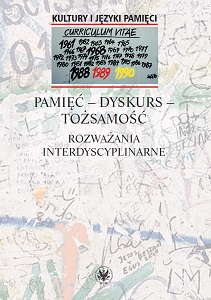
Memory – Discourse – Identity. Interdisciplinary Reflections is a bilingual book aligning with the memorial discourse trend. It contains reflections on the condition of man and the world in the context of Polish and German memory discourse in the post-war culture. The authors refer to the category of memory in public and private dimensions and present various approaches to the issues of memory turn and transformations concerning mutual relations and interpenetration of literature, music, art. And contemporary media. The book includes the papers written by German and Polish studies scholars, historians, and art. Historians from Poland, Germany and Spain.
More...
The article analyses the collages of Herta Müller as an appropriate means of articulating traumatic experiences made under the regime of rumanian dictator Ceausescu. The own liminal position and the contingency of west-german print-media offer a space for poetological reflections and experiments. Müller develops a strategy of playfulness that allows to free traumatic experiences and initiates a process of healing memory. The collages also try to give an answer to the question, to what extent the terror experienced in the Past can be articulated across aesthetic forms.
More...
On the basis of relevant works of art contemporary concepts about remembrance will be presented to the forced migration of Germans. This is Christine Bachmann with “BIRKENORT. VANISHING POINTS”, Rosemarie Zens with The Sea Remembers David Adam with Marie Scheibner, among other things, Heike Lydia Grüß with Der getrübte Körper/The clouded body, Yvon Chabrowski with Sun + Land + Diagonal and Sven Johne with Ostpreußen/East Prussia. The works were created in the period from 2003 to 2014 and situate itself in the Czech Republic, Poland and the Kaliningradskaya Oblast. The media of photography and film are preferred. The focus is on critical analysis of the traditional canon of motifs, with image structures and mechanisms of presentation.
More...
The main assumption of presented article is dwelling on the term of memory and ways of presenting the past in modern culture on the example of the work of a painter Miroslaw Balka. The artist is characterized by a visual acuity of phenomena surrounding him and a special concentration on the other man with all aspects of his life as well as awareness of the past, his own biography and the artistic work. Time and history influence his work and are shaping their form.
More...
The German trilogy consists of three films by Christoph Schlingensief: „Das deutsche Kettensägenmassaker“, „100 Jahre Adolf Hitler“, „Terror 2000“. On the political uncorrect way the regisseur deals with the unsolved problem of the getting over of the Nazi-time and its delayed effect of neo-nazizm and the east-west-confrontation after the German reunion. He represents hereby a different opinion from the official political line.
More...
This article presents ways in which memory can exist in digital texts. We characterize digital representations of the work of human memory, the influence of digital technology and changes in the digital narration on realization of mnemonic function of the text (e.g. the use of the perceptive linearity, intersemiotic repetition, engaging the user in the creation of texts). Structural tricks and textual strategies used to create the textual representation of different existing forms of memory are analyzed on the example of digital poetry and hypertext narration. These are for instance: the remembering, the mentioning, the recalling, the presenting of the past.
More...
In the analyzed Polish mems a selective treatment of culture and a duplicationof stereotypes concerning the appearance of German women,men and the German language can be observed. However, in the memsthere appear new elements which are connected with a clever observationof the changes that take place, and an awareness of the existenceof stereotypical images, and, perhaps, an attempt at referring to themin a perverse way (a series Ładna Niemka – ‘A Pretty German Woman’).In the series with the phrase Niemiec płakał, jak sprzedawał (A Germanwas crying as he was selling) we can notice a play with the typicalperception of German cars, their owners and the arguments of carsalesmen. Therefore, on the one hand, mems strenghten conventionalperspectives, and on the other hand, they oppose them, frequentlyshowing their absurdity, ridiculousness and conventionality.
More...
The article presents an analysis of the construction of the memory in the book Jerominkinder by Ernst Wiechert. In the first part the author describes the reception of Wiechert’s work in Poland in consideration of a turning point in 1989. After that, the author passes on a definition of the memory. The next part describes the most important elements of the memory of the inhabitants of Sowirog. The wars, above all the World War I, and the persons of Mr. von Balk and Michael Jeromin were mentioned.
More...
Shtetl, a mosaic of cultures, languages and religions, was presented by Polish-Jewish artists of the interwar period as a juxtaposition of two worlds: the idyllic world of childhood and the ugly, miserable place of Jewish existence in Eastern Europe. After the Holocaust the portrayal of shtetl became the symbol of the lost world of European Jewry. This essay focusses on two Polish-Jewish artists: a poet Stefan Pomer, who came from a Podolian shtetl and became victim of the Holocaust and an artist Adam Muszka, a Holocaust survivor, who devoted his life to painting a shtetl of his childhood Piotrków Trybunalski, and examines how the memory of shtetl is represented in their works.
More...
The past does not exist objectively. It exists as an image in our memory. The following article is devoted to the perception of the past related to the Second World War by representatives of two different communities – Polish and German. The example of the memory of the Jewish community that lived before the World War II in contemporary Poland will show a different sensitivity of perceiving facts related to this period, depending on the social framework of the two nations.
More...
The article discusses memory processes that occur above all in the context of the cemetery. The first part demonstrates Jan Assmann's conceptof the memory which concerns the recollection of the dead through special tokens, rites and institutions. The remainder of the article presents examples of gravestone inscription with their narrative potential, gravestone photos, church and secular rites such as celebrations or name giving practices. Next there is shown the process of forgetting that occurs in anonymous burial sites and new burial places.
More...
The presented article is devoted to the problem of identification of terms other than typical proper names. The author discusses the current state of research on the category of individual descriptors and terms considered to be equivalents of proper names, recalling both onomastic theories and research of scholars from other disciplines. The issues addressed include the formal appearance of these terms, their importance in the identification process and the textual function. The exemplification of theoretical assumptions and author’s own interpretative claims consists in the quasi-names derived from contemporary texts, among others those by I. Karpowicz and J. Sosnowski.
More...
The authors give careful thought to selected digital “memorial sites” dedicated to distinguished creators of culture, literature and art (and collected under the banner of the KARTA Centre Foundation), such as Witold Lutosławski, Józef Gosławski, Agnieszka Osiecka, Wisława Szymborska, Pola Negri, Jerzy Grzegorzewski or Zofia Rydet. The overview of the collected material has assumed a search for (non)normative biographies, i.e. multi-modal, “patchwork,” “moving” biographies, as well as a confrontation of the observed patterns with well-established modes in biographical writing. What is more, the authors noted the liminal, borderline characteristics of the approaches, styles, genres etc. used today for various discursive practices that evoke or shape the images of the past. The conducted analyses, which have inscribed themselves into the stream of reflections on the phenomenon of the social archive and which are discursively and genologically oriented (cf. the assumptions and research methods of memory linguistics referred to in the text), have provided answers to, among others, the following specific questions: who the social actors reflected in the mirror of biographical archives (i.e. the creators and recipients of archives) are and what are their motivations; which people (and why these particular ones) are commemorated there, as well as through the prism of which objects a person’s profile is built.
More...
Scholars in various fields of science are increasingly asking themselves the question of subjectivity in the modern world. Similarly, the subject remains a topic of discourse in art. This article constitutes an attempt to analyze the discourse of posthumanism in Tomasz Matkowski’s novel And God Created a Dolphin, or: a Human Dish. The proposed reflections also attempt to answer the question of how the discourses of posthumanism can be realized in literary texts on different textual levels and areas of communication.
More...